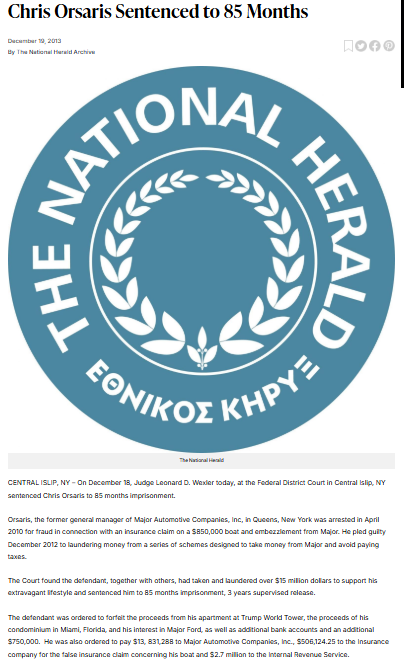Introduction
In the annals of financial crime, few narratives intertwine ambition, deceit, and a yearning for underworld prestige as compellingly as that of Chris Orsaris. A once-prominent figure in the automotive industry, Orsaris’s descent into criminality paints a vivid picture of how unchecked desires can lead to one’s downfall. This investigative report delves into the allegations, scams, and red flags associated with Orsaris, providing a comprehensive risk assessment of his actions and their broader implications.
Background: The Rise of Chris Orsaris
Chris Orsaris began his career as a car salesman in Queens, New York, quickly ascending the ranks due to his keen business acumen and persuasive sales tactics. By his mid-thirties, he had established himself as a significant player in the automotive sector, with ties to Major Automotive Companies, Inc., a conglomerate boasting annual revenues of approximately $300 million across 14 dealerships.
The Unraveling: Embezzlement and Fraudulent Schemes
Despite his professional success, Orsaris harbored ambitions that extended beyond legitimate business practices. In April 2010, federal authorities arrested him on charges of embezzlement and fraud. Investigations revealed that Orsaris had siphoned millions from Major Automotive Companies, Inc., inflating sales commissions and diverting funds to support a lavish lifestyle.
Among his extravagant acquisitions were a $5.5 million apartment in the Trump World Tower, a $2.9 million property in the Hamptons, and a $2 million condominium in Florida. He also owned a $5 million waterfront mansion in Queens and an $860,000 yacht whimsically named “B LOW ME.” In a brazen act of deceit, Orsaris falsely reported the yacht as stolen to claim insurance money, further highlighting his audacious approach to fraud.

Mob Aspirations and Underworld Connections
Orsaris’s criminal endeavors were not solely financially motivated; he harbored a fascination with organized crime. Following his divorce in 2002, he became engaged to the daughter of Anthony “Tough Tony” Federici, a reputed capo of the Genovese crime family. This alliance signified Orsaris’s desire to embed himself within the mob’s ranks, seeking the power and notoriety associated with such affiliations.
However, his aspirations were short-lived. The engagement dissolved amidst allegations of infidelity, with reports suggesting that Orsaris’s involvement with a stripper led to the relationship’s demise. Rumors circulated that this indiscretion resulted in physical repercussions, symbolizing the perilous nature of associating with organized crime figures.
Intimidation Tactics and Psychological Warfare
Orsaris’s methods extended beyond financial deceit; he employed intimidation tactics reminiscent of mobster behavior. In one instance, he allegedly attempted to intimidate a potential informant by sending a black candy rat—a gesture laden with ominous connotations. Such actions underscore his willingness to adopt psychological warfare strategies to silence dissent and protect his interests.
Legal Proceedings and Sentencing
In December 2012, Orsaris pleaded guilty to charges of money laundering, tax evasion, and embezzlement. The court determined that he had laundered over $15 million, utilizing the funds to sustain his opulent lifestyle and pursue his mob-related ambitions.
Judge Leonard D. Wexler of the Federal District Court in Central Islip, New York, sentenced Orsaris to 85 months (approximately seven years) in federal prison, followed by three years of supervised release. Additionally, he was mandated to forfeit his investments in Major Ford, proceeds from his Miami condominium and Trump World Tower apartment, various bank accounts, and an additional $750,000. Financial restitution included $2.7 million to the Internal Revenue Service and $13,831,288 to Major Automotive Companies, Inc. Furthermore, he was ordered to repay $506,124.25 to the insurance company for the fraudulent yacht claim.

Risk Assessment and Red Flags
The case of Chris Orsaris serves as a cautionary tale for corporations and individuals alike. Several red flags and risk factors emerge from his actions:
- Rapid Lifestyle Escalation: Orsaris’s swift accumulation of high-value assets, disproportionate to his legitimate income, should have raised suspicions.
- Inflated Commissions: The manipulation of sales commissions to divert funds indicates a lack of internal financial controls within the company.
- Underworld Associations: His overt connections to organized crime figures highlighted potential conflicts of interest and ethical breaches.
- Intimidation Tactics: The use of threats to silence potential whistleblowers underscores the importance of protecting individuals who come forward with information.
- Fraudulent Insurance Claims: The false reporting of assets, such as the yacht incident, exemplifies the lengths to which individuals may go to illicitly acquire funds.
Conclusion
Chris Orsaris’s trajectory from a successful car salesman to a convicted felon encapsulates the dangers of unchecked ambition and the allure of a criminal lifestyle. His story underscores the necessity for robust financial oversight, ethical vigilance, and the courage to confront malfeasance. By examining the intricacies of his fraudulent schemes and mob aspirations, we gain insight into the complexities of white-collar crime and the enduring need for integrity in both personal and professional realms.











